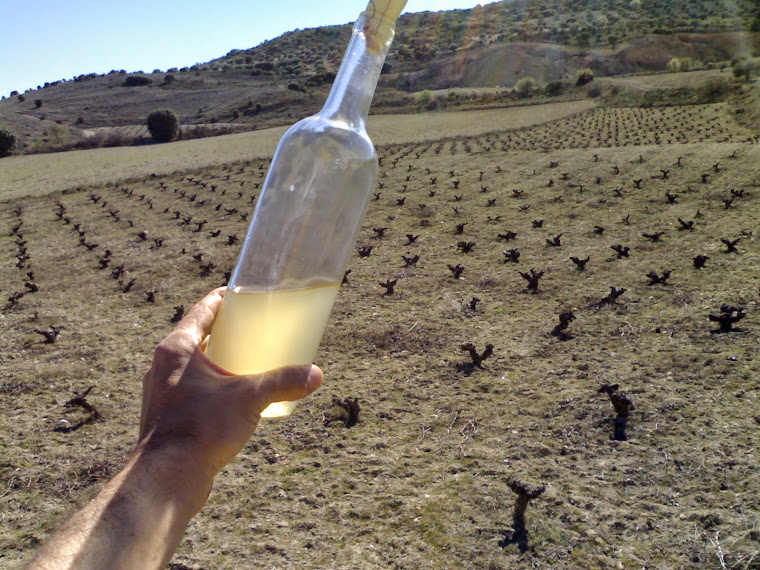Background
Last Saturday we pressed the grapes from our clay amphora. This is an experimental lot of about 300 kg of grapes that we crushed and fermented back in September 2011. Ever since we moved ito the current winery in Morata de Tajuña a few years ago, I'd been noticing these two old clay amphorae sitting in a corner of the patio, gathering dust and leaves. So finally, last August, I made the effort, and I managed to convince Juan (my partner) and the other Juan (the owner of the winery and of the amphorae) to clean one and to use it to make wine.
So in Spetember, when we harvested the Malvar grapes from our new vineyard in Villarejo, we filled up the amphora with manually crushed grapes, sealed it, and basically left it alone (see this post). We didn't add any substances at all (no SO2) and we just punched down the cap every so often until the skins didn't float any more. Anyway, that's 5 months of skin contact.
During this time, the skins, pips, lees, etc all sank to the bottom and the top became liquid - a golden transparent liquid.. Every so often we would open up the 'lid' (a plastic sheet tied down tightly) and we would taste the wine to see how it was developing.
Operations
Phase 1, as is the case with any of our operations, was cleaning and setting up. In this case it was quite simple as all we needed was a basket press, a stainless steel tank and pneumatic lid, and some assorted bits and pieces.
Cleaning the press and tank
Phase 2 was scooping out the liquid part from the top of the amphora. We used buckets and poured it straight into a separate airtight container, not into the press. We want to keep this wine separate from the wine we press off the grapes, to see if they are different in any way. With hindsight, we realized that we could have moved this wine by gravity, just using a simple plastic hose or tube, but we didn't think that there would be so much of it. We expected only a few bottles worth, but we ended up with about 50 liters. A little lesson learned there for the future!
Juan scoops out wine
Pouring and filtering
Juan and Juan scooping out grapes
Pouring into the press
Amphora secured to wall
But it was no use! We still couldn't reach all the way down to the bottom, so we laid it down horizontally.
Horizontal
Mission accomplished! And with the added bonus that the quantity on the amphora was just right to fill the basket press, so we could press the lot in only one session. :)
Pressing is hard work!
Mushy grapes
Murky turbid wine. Note the ingenious filtering device!
Phase 5. The last phase is always cleaning the equipment used and tidying up. A great bore to be sure, but really necessary!
Hosing down
Cleaning out
We were all surprised at the quality of both the liquid wine at the top and of the soupy gunge at the bottom. There were absolutley no off-tastes or off-aromas. During the tastings over the last 5 months, the dominant tastes and aromas were those of clay and earth! And we weren't really too happy about that. But on Saturday, for the first time, we tasted the wine physically far away from the amphora (we went outside into the patio), and the clay and earth tastes and aromas were almost gone! They certainly weren't dominant. Instead we could taste 'normal wine' with notes of citrus, quite tannic and mineral and bitter, but with some sweetness there too. We think that this wine has got some way to go still, and that it will age well. In fact, we're thinking of looking for a used oak barrel, that was used for white wine, and ageing it in there for a while. In a week or so, depending on tastings, and ambient temperatures, and level of clarification, we'll rack off the big lees, let it settle down again, and see how it develops. Maybe we'll keet the two lots separate or maybe mix them back together again.
Nice clear golden wine from the top of the amphora
I wonder how they did it in the old days before stainless steel and when clay amphorae were common, especially the big fat ones that ccould hold thousands of liters. How on earth did the move the grapes/must/wine/pomace?
Surprise Visit
Mid-morning as we were pressing the grapes, we received a surprise visit from a group of people who are going to open a stall in the Municipal Market (in the Lavapiés District of Madrid), selling organic wine, not only in bottles but also loose, by the liter, in recyclable, reusable containers, in some arrangement with their customers. I think that's a great initiative, as these municipal markets are kind of languishing these days - I suppose due to competition from supermarkets, shopping malls and an aging population in the city centre.
They told me that the Ayuntamiento (City Council) has relaxed its Byzantine requirements for obtaining a license, but that even so it was still a Kafkaesque nightmare! They haven't actually got their license yet, but they've started sourcing their local organic wines already - hence their surprise visit. After us, they were off to see another organic wine producer Andrés Morate in Belmonte del Tajo. Anyway, I hope they like the samples we gave them and that they succeed in obtaining their license and that they order some wine from us :)















No comments:
Post a Comment
Please write a comment to this post.